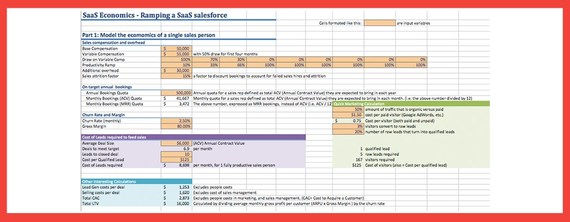Scaling a sales team is one thing; scaling a successful sales team is another story.
We spoke with Matthew Bellows, CEO of Yesware, and he shared five lessons learned from growing Yesware into a product that over 800,000 sales people use.
They are obviously doing something right.
These five lessons were inspired from Matthew's time as a salesperson and sales manager, and they range from when to hire the first salesperson to how to stay sane through the uncertainty of scaling your business.
Bellows shares some great insight, so let's get to it.
1. The Founder Should Bring In The First $1 Million
Before you really worry about scaling a sales team, or building one in the first place, one thing must be clear: the founder needs to be the first salesperson.
In fact, the founder should be able to bring in the first $1 million in revenue before hiring a single outside salesperson.
If the founder can't sell the product and drive the first $1 million, they most likely won't be able to hire someone that does. No one knows the product, the problem it solves, and why people need it better than the founder.
Why $1 million? Matthew says, quite simply, it's a nice tangible benchmark to strive for.
Even if the founder has no background in sales, they should be able to pitch and sell this product that they know inside and out. This is a good test for both the validity and the longevity of the business.
If the founder can't sell it, it may be time to rethink the product. That might sound a bit harsh, but it's better to know before bringing an entire sales team onto payroll.
2. Hire 2-3 Salespeople At Once
Once that $1 million revenue mark is conquered, there is confirmation that the product is valuable to the market. Now, it's time to start bringing in outside help.
At Yesware, they started with one salesperson, because they knew it would be a challenge for a non-founder to sell something that they didn't help create.
Looking back on it now, Bellows suggests that, if possible, it's better to hire 2-3 salespeople at a time.
If sales are stagnating, by only hiring one salesperson you have no way of knowing if the person isn't right for your product or if the product itself is a dud. You know from the first $1 million in revenue that it can be sold, but that doesn't tell you much about staying power.
However, if you have three people come onto the team at once and one of them succeeds while the other two don't, you know it's possible to achieve your desired sales in the long-term.
It also gives you a better indicator of what type of salesperson you need to hire next based on the qualities of the successful rep(s).
If you followed step one, you already have a list of clients to show your first round of salespeople. You want that list to be a catalyst and confidence-booster for the team.
They should be thinking "If the founder can bring in this kind of revenue while driving the business in other ways, then I should be able to top that by selling full-time."
If you hire two or three salespeople at once, it will be easier to tell who has this type of can-do attitude. These types of observations will also help with hiring decisions down the road.
3. Use Metrics to Gauge Success
Bellows uses this spreadsheet, from David Skok of Matrix Venture Capital, to track metrics on his salespeople in order to better scale his team. At Yesware, they've tweaked and added to this spreadsheet for five years, but the essence of it remains the same.
The spreadsheet helps solidify both sales and marketing metrics, so that you can better see how the two come together. As for how it helps to scale a sales team, you enter the information on each person to track their progress and you get an idea of how quickly their work will become profitable.
For each salesperson, the sheet tracks base compensation, variable compensation, how quickly he or she reaches quota, average deal size, churn (how long customers stick with you), and a few other details to get a comprehensive view of the rep's progress.
Ultimately, the spreadsheet helps to see how quickly a salesperson will be able to turn a profit.
Ideally, they should turn a profit within six months, but if not, definitely within a year. Otherwise it's a good indicator that the partnership isn't going to work out.
If they aren't going to make the one-year goal, it's probably time to cut your loss.
It helps to know early on if a salesperson is going to be profitable for your company, because you don't want to waste your time losing revenue. You also don't want to waste their time by them trying to sell a product that isn't a good match.
Letting people go is never easy, but it helps to remember that you are helping them as well as yourself. If it is clear that they are more likely to succeed elsewhere, you aren't doing them any favors by keeping them around.
4. Know When to Add to the Team
The point at which you're ready to add another salesperson can be difficult to recognize, because while data can be helpful, it is unlikely to give you the full story.
The short, standard answer is that you should add another salesperson once you have more leads than you know what to do with. However, it rarely works out that neatly.
For one thing, the salespeople you already have on hand are generally going to want new or better leads almost constantly. Any additional person who joins the ranks is likely to be seen as an interloper.
To really know when it's time to add an extra body to the team, you do want to look at the metrics, but you'll also need to trust your gut instincts.
Keeping track of things like lead numbers, how well leads flow through the sales funnel, and how quickly leads are increasing month-to-month or quarter-to-quarter will help you feel out the best time to expand your sales team.
For most companies, market size is not an issue. Instead, the issue is whether or not you can inform the market about your product.
More salespeople means having more opportunities to connect with leads and get the word out, but adding too many salespeople can dampen profits if they aren't effectively turning that information saturation into actual deals.
That said, when you have a great product and your system is working well, it might be a good idea to add another salesperson before you actually think you need them. It can be a good push for the current team members to go after the existing leads.
Data is helpful for knowing when to add someone to your sales team, but this issue is quite a bit more nuanced than a spreadsheet can fully cover. There's a lot of uncertainty.
Bellows admitted that he and the team at Yesware made some mistakes and stumbled along the way to 800,000+ clients, but in the end, mistakes are what help you grow.
As you figure out how to scale your sales team, those decisions will become easier. In the beginning, look to the metrics as guidance and trust your intuition.
5. Put Things in Perspective
Speaking of making mistakes, it would be great if there were a step-by-step guide on how to flawlessly scale your sales team without lost revenue or wasted time.
Unfortunately, such a thing does not exist. There are several books on how to scale a sales team, but most deal with specific companies and their success stories.
While there are things to be learned from the successes of others, hindsight is 20/20, and things are likely to be far more complicated while you are struggling with the same issues. It's important to embrace the uncertainty and keep things in perspective.
As the German military strategist Helmuth von Moltke said, "No battleplan ever survives contact with the enemy." The enemy in this sense is reality. Bad luck happens, so there will be no straight path to success.
For your sanity and the success of your business, it's a good idea to keep this in mind when you stumble in a decision or when things don't seem to be going your way.
You need to accept the bad luck as it comes and let the stress slide away. People don't perform well when stressed, so fretting over a mistake or a snag in the plan won't help you overcome the issues at hand.
Conclusion
There is no simple road map for how to scale your sales team, but these lessons helped grow Yesware into the 800,000+ user company it is today.
By remembering that the founder must prove to be a successful salesperson first and foremost, there is power in hiring in numbers, metrics are your friend, you should trust your gut, and that keeping things in perspective is vital to the success of your company, you can overcome most hurdles when scaling your business.
This article is based on an interview with Matthew Bellows, CEO of Yesware.
You can find the interview that this post was based on, and many more, by subscribing to the B2B Growth Show on iTunes.
___________________________________________________________
James Carbary is the founder of Sweet Fish Media, a podcast production service for B2B companies. He's a contributor for the Huffington Post & Business Insider, and he also co-hosts the B2B Growth Show: a podcast dedicated to helping B2B executives achieve explosive growth.





